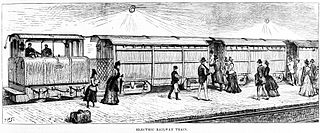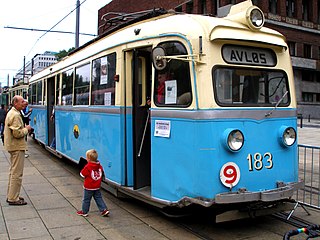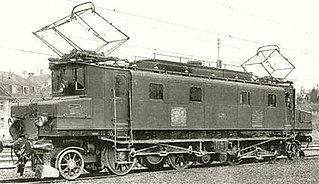
A bogie is a chassis or framework that carries a wheelset, attached to a vehicle—a modular subassembly of wheels and axles. Bogies take various forms in various modes of transport. A bogie may remain normally attached or be quickly detachable ; it may contain a suspension within it, or be solid and in turn be suspended ; it may be mounted on a swivel, as traditionally on a railway carriage or locomotive, additionally jointed and sprung, or held in place by other means.
As used in mechanical engineering, the term tractive force can either refer to the total traction a vehicle exerts on a surface, or the amount of the total traction that is parallel to the direction of motion.
The UIC classification of locomotive axle arrangements, sometimes known as German classification or German system, describes the wheel arrangement of locomotives, multiple units and trams. It is set out in the International Union of Railways (UIC) "Leaflet 650 – Standard designation of axle arrangement on locomotives and multiple-unit sets". It is used in much of the world. The United Kingdom uses the Whyte notation. The United States uses the simplified AAR wheel arrangement for modern locomotives.

Under the Whyte notation for the classification of steam locomotives, 4-2-0 represents the wheel arrangement of four leading wheels on two axles, two powered driving wheels on one axle and no trailing wheels. This type of locomotive is often called a Jervis type, the name of the original designer.
B-B and Bo-Bo are the Association of American Railroads (AAR) and British classifications of wheel arrangement for railway locomotives with four axles in two individual bogies. They are equivalent to the B′B′ and Bo′Bo′ classifications in the UIC system. The arrangement of two, two-axled, bogies is a common wheel arrangement for modern electric and diesel locomotives.

Electric locomotives were first used on the London Underground when the first deep-level tube line, the City and South London Railway (C&SLR), was opened in 1890. The first underground railways in London, the Metropolitan Railway (MR) and the District Railway (DR), used specially built steam locomotives to haul their trains through shallow tunnels which had many ventilation openings to allow steam and smoke to clear from the tunnels. It was impractical to use steam locomotives in the small unvented tubular tunnels of the deep-level lines, and the only options were rope haulage or electric locomotives.

A wheelset is the wheel–axle assembly of a railroad car. The frame assembly beneath each end of a car, railcar or locomotive that holds the wheelsets is called the bogie. Most North American freight cars have two bogies with two or three wheelsets, depending on the type of car; short freight cars generally have no bogies but instead have two wheelsets.

SL79 is a class of 40 articulated trams operated by the Oslo Tramway of Norway. The trams were a variation of the Duewag trams that had been developed by the German manufacturer since the 1950s. The six-axle vehicles are unidirectional with four doors on the right side. The trams can seat 77 passengers three and four abreast, with an additional 91 people able to stand. Power output is 434 kilowatts (582 hp), provided by two motors on the two end bogies, that supplement a central unpowered Jacobs bogie located under the articulation. The trams are 23.0 metres (75.5 ft) long and 2.5 metres wide. They are capable of 80 kilometres per hour (50 mph) and have standard gauge.

The Gölsdorf axle system is used on railway Gölsdorf locomotives to achieve quiet running and low wear-and-tear when negotiating curves. The axle system comprises a combination of fixed axles and axles that can slide transversely, all within a single, rigid locomotive frame. The system was invented by a young Austrian locomotive builder, Karl Gölsdorf, around the end of the 19th century. The first locomotive to use this principle entered service in 1897.
WAG is a code given by Indian Railways to a series of electric locomotives, run in India. W is for broad gauge, A is for AC traction and G is for goods duty. They are the most powerful engines in the country yet. There are 9 WAG models and each model has further variations.

Class B and Class E, normally referred to as Gullfisk, were a class of 46 trams built by Strømmens Værksted and Skabo Jernbanevognfabrikk for Oslo Sporveier and Bærumsbanen of Oslo, Norway, in 1937 and 1939. They were the first aluminium trams to operate on the Oslo Tramway and the first bogie trams to operate on street lines. They had contemporary modern electronic equipment, a streamlined shape, and comfortable accommodation. Till 1964, they were also faster than any other Norwegian tramcar or suburban railcar.
Integral Coach Factory (ICF) coaches are conventional passenger coaches used on the majority of main-line trains in India. The design of the coach was developed by Integral Coach Factory, Perambur, Chennai, India in collaboration with the Swiss Car & Elevator Manufacturing Co, Schlieren, Switzerland in the 1950s. The design is also called the Schlieren design based on the location of the Swiss company. The 1st ICF coach had been flagged by then Prime Minister Jawaharlal Nehru on 2 October 1955. The last ever ICF coach was flagged off by senior technician Shri Bhaskar P. in the presence of Railway Board Chairman Ashwani Lohani on 19 January 2018 - Indian Railways intends to phase out ICF coaches and replace all of them with the newer LHB coaches.

The Be 4/6 12301 was one of four test locomotives ordered by the Schweizerischen Bundesbahnen (SBB) in June 1917. For gaining experience for ordering electrical locomotives this locomotive should – as her three sisters Be 3/5 12201, Be 4/6 12302 and Ce 6/8I14201 – have been used for services on the Gotthardbahn. The Be 4/6 12301 was the alternative design of MFO for a fast train locomotive for the Gotthard railway line. She was designed and built according to the requirement specifications of the SBB. But – except for occasional trips to the maintenance shop of Bellinzona – did not appear on the Gotthard railway line. The design was intrinsically reliable. The locomotive was operating during 44 years in very various services. The locomotive drivers liked the locomotive because her driving behaviour was very smooth even at top speed. But technically the locomotive was much more complicated than their sisters Be 4/6 12302 and Be 4/6 12303-12342.

The South African Railways Class 21 2-10-4 of 1937 was a steam locomotive.

A steam motor is a form of steam engine used for light locomotives. They represented one of the final developments of the steam locomotive, in the final decades of the widespread use of steam power.

The 2BB2 400 class were two electric locomotives built in 1926 for the Paris Orléans (PO) railway of France.
A monomotor bogie is a form of traction bogie used for an electric locomotive or diesel-electric locomotive. It is distinguished by having a single traction motor on each bogie.

The SNCF CC 40100 was a French class of quad-voltage 4,340 kW (5,820 hp) electric locomotives. They were intended for high-performance passenger services on the Trans Europ Express (TEE) routes of the 1960s and 1970s. This non-stop international working required them to support the electrical standards of several networks. They are significant for combining three innovations in locomotive design: quad-voltage working, three-axle monomotor bogies and the new 'Nez Cassé' body style of French locomotives.

Rigid-framed electric locomotives were some of the first generations of electric locomotive design. When these began the traction motors of these early locomotives, particularly with AC motors, were too large and heavy to be mounted directly to the axles and so were carried on the frame. One of the initial simplest wheel arrangements for a mainline electric locomotive, from around 1900, was the 1′C1′ arrangement, in UIC classification.















